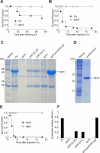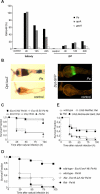Prevalence of local immune response against oral infection in a Drosophila/Pseudomonas infection model
- PMID: 16789834
- PMCID: PMC1475658
- DOI: 10.1371/journal.ppat.0020056
Prevalence of local immune response against oral infection in a Drosophila/Pseudomonas infection model
Abstract
Pathogens have developed multiple strategies that allow them to exploit host resources and resist the immune response. To study how Drosophila flies deal with infectious diseases in a natural context, we investigated the interactions between Drosophila and a newly identified entomopathogen, Pseudomonas entomophila. Flies orally infected with P. entomophila rapidly succumb despite the induction of both local and systemic immune responses, indicating that this bacterium has developed specific strategies to escape the fly immune response. Using a combined genetic approach on both host and pathogen, we showed that P. entomophila virulence is multi-factorial with a clear differentiation between factors that trigger the immune response and those that promote pathogenicity. We demonstrate that AprA, an abundant secreted metalloprotease produced by P. entomophila, is an important virulence factor. Inactivation of aprA attenuated both the capacity to persist in the host and pathogenicity. Interestingly, aprA mutants were able to survive to wild-type levels in immune-deficient Relish flies, indicating that the protease plays an important role in protection against the Drosophila immune response. Our study also reveals that the major contribution to the fly defense against P. entomophila is provided by the local, rather than the systemic immune response. More precisely, our data points to an important role for the antimicrobial peptide Diptericin against orally infectious Gram-negative bacteria, emphasizing the critical role of local antimicrobial peptide expression against food-borne pathogens.
Conflict of interest statement
Figures






Similar articles
-
Insecticidal activity of the metalloprotease AprA occurs through suppression of host cellular and humoral immunity.Dev Comp Immunol. 2018 Apr;81:116-126. doi: 10.1016/j.dci.2017.11.014. Epub 2017 Nov 23. Dev Comp Immunol. 2018. PMID: 29174605
-
A secondary metabolite acting as a signalling molecule controls Pseudomonas entomophila virulence.Cell Microbiol. 2010 Nov;12(11):1666-79. doi: 10.1111/j.1462-5822.2010.01501.x. Epub 2010 Aug 17. Cell Microbiol. 2010. PMID: 20597908
-
Association of hemolytic activity of Pseudomonas entomophila, a versatile soil bacterium, with cyclic lipopeptide production.Appl Environ Microbiol. 2010 Feb;76(3):910-21. doi: 10.1128/AEM.02112-09. Epub 2009 Dec 18. Appl Environ Microbiol. 2010. PMID: 20023108 Free PMC article.
-
Confronting physiology: how do infected flies die?Cell Microbiol. 2007 Dec;9(12):2775-83. doi: 10.1111/j.1462-5822.2007.01042.x. Epub 2007 Sep 20. Cell Microbiol. 2007. PMID: 17883424 Review.
-
Drosophila immune response: From systemic antimicrobial peptide production in fat body cells to local defense in the intestinal tract.Fly (Austin). 2010 Jan-Mar;4(1):40-7. doi: 10.4161/fly.4.1.10810. Epub 2010 Jan 2. Fly (Austin). 2010. PMID: 20383054 Review.
Cited by
-
Drosophila melanogaster larvae are tolerant to oral infection with the bacterial pathogen Photorhabdus luminescens.MicroPubl Biol. 2023 Aug 29;2023:10.17912/micropub.biology.000938. doi: 10.17912/micropub.biology.000938. eCollection 2023. MicroPubl Biol. 2023. PMID: 37711508 Free PMC article.
-
Drosophila are protected from Pseudomonas aeruginosa lethality by transgenic expression of paraoxonase-1.J Clin Invest. 2008 Sep;118(9):3123-31. doi: 10.1172/JCI35147. J Clin Invest. 2008. PMID: 18704198 Free PMC article.
-
Characterization of an insecticidal toxin and pathogenicity of Pseudomonas taiwanensis against insects.PLoS Pathog. 2014 Aug 21;10(8):e1004288. doi: 10.1371/journal.ppat.1004288. eCollection 2014 Aug. PLoS Pathog. 2014. PMID: 25144637 Free PMC article.
-
The route of infection determines Wolbachia antibacterial protection in Drosophila.Proc Biol Sci. 2017 Jun 14;284(1856):20170809. doi: 10.1098/rspb.2017.0809. Proc Biol Sci. 2017. PMID: 28592678 Free PMC article.
-
Identification of the protective effects of traditional medicinal plants against SDS-induced Drosophila gut damage.Exp Ther Med. 2016 Oct;12(4):2671-2680. doi: 10.3892/etm.2016.3641. Epub 2016 Aug 31. Exp Ther Med. 2016. PMID: 27698771 Free PMC article.
References
-
- Schneider D. Using Drosophila as a model insect. Nat Rev Genet. 2000;1:218–225. - PubMed
-
- Vodovar N, Acosta C, Lemaitre B, Boccard F. Drosophila: A polyvalent model to decipher host-pathogen interactions. Trends Microbiol. 2004;12:235–242. - PubMed
-
- Tzou P, De Gregorio E, Lemaitre B. How Drosophila combats microbial infection: A model to study innate immunity and host-pathogen interactions. Curr Op Microbiol. 2002;5:102–110. - PubMed
-
- Hultmark D. Drosophila immunity: Paths and patterns. Curr Opin Immunol. 2003;15:12–19. - PubMed
-
- Ha EM, Oh CT, Ryu JH, Bae YS, Kang SW, et al. An antioxidant system required for host protection against gut infection in Drosophila . Dev Cell. 2005;8:125–132. - PubMed
Publication types
MeSH terms
Substances
LinkOut - more resources
Full Text Sources
Medical
Molecular Biology Databases

